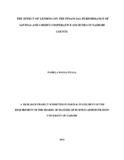The Effect of Lending on the Financial Performance of Savings and Credit Cooperative Societies in Nairobi County
Abstract
As development takes place, one question that arises is the extent to which credit can be offered
to the rural poor to facilitate their taking advantage of the developing entrepreneurial activities.
Lending is the trust which allows one party to provide resources to another party where that second
party does not reimburse the first party immediately (thereby generating a debt), but instead
arranges either to repay or return those resources (or other materials of equal value) at a later date.
Descriptive design was used in the study. Descriptive research was used to obtain information
concerning the current status of the phenomena to describe "what exists" with respect to variables
or conditions in a situation. This design aimed at determining the effect of lending on SACCOs'
financial performance.
The researcher used secondary data. Secondary data was collected from the Sacco financial
statements and policies. Literature was reviewed using secondary data sources including other
dissertations, journals, Sacco's financial reports, SACCO's Act, Sacco supervision annual report,
internet, research projects and information from the university library. Data was collected from
target population which shall comprise of 34 licensed SACCOs in Nairobi County as per Sacco
supervision annual report 2012 by Sacco Regulatory Authority (SASRA).Descriptive analysis
involving: frequencies, percentages, means, modes, medians, standard deviation, variances will
then be used. The study used a multiple linear regression analysis on secondary data. The following
variables were entered in the regression: profitability, lending volume, loan default, lending
interest rate, total deposit value. The study also found that loan default negatively impact on the
financial performance of SACCO in Nairobi county.
The finding indicated that average interest rates for loans for the past five financial years from
2009 to 2013 raised from 8.0514 to 13.011.This increase was gradual throughout the study period.
Findings indicated that there was a negative relationship between the interest rates charged by the
Sacco’s. The upward adjustments of Sacco’s interests on term loans are in order to cushion
themselves of the regulatory effects. The study recommends that SASRA has great impact on the
Sacco performance in terms of outreach and sustainability. Most Sacco’s improvement on
performance both in membership, portfolio and loan cycle and general efficiency was attributed to
a number of factors ranging from increased membership, high efficiency, high demand and quick
recoveries; which was attributed to SASRA regulatory framework. Sound default Loan provision
policies should be established by Sacco’s. They should make adequate loan provisions to promote
safety of funds. This will ensure that loan assets are not overstated and recovery simplified within
the regulation frame work. SACCOs should adopt competition that requires effective risk
management, effective savings mobilization strategies on members’ savings mobilization and see
the need to develop marketing and new products/services strategies to make members to benefit
from competitive interest rates on loans borrowed and to provide a wider selection of financial
products/services.

